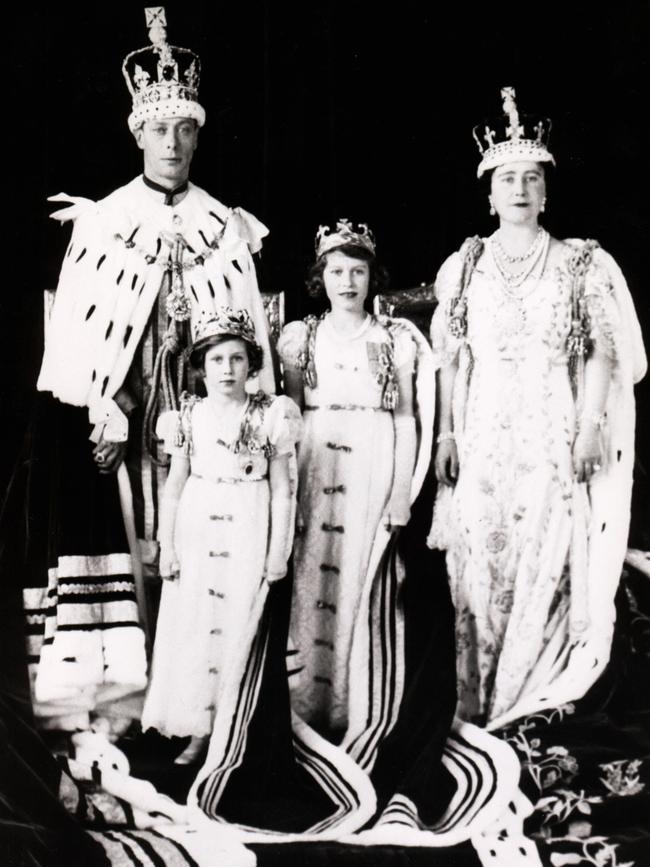The Queen, her parents and sister formed a tight-knit group – ‘us four’
The Queen’s childhood was happy and peaceful, the family’s strong bonds preparing her for a future that was then unforeseeable.

Days after the young Princess Elizabeth married Prince Philip, a man her father liked and respected, she received a letter from King George VI.
How proud, how thrilled he was, he told her, to have his eldest daughter at his side “on our long walk in Westminster Abbey.”
However he added, in the letter that has famously come to define the unique bonds of their close-knit family: “When I handed your hand to the Archbishop I felt I had lost something very precious. Our family, us four, the ‘royal family’ must remain together …”
“Us four.” Prince Albert, “Bertie” and his wife, Elizabeth Bowes-Lyon, had determined early on that their little family of four – the couple with their daughters Elizabeth and Margaret – would form their own bastion against the storms that swirled around the royal family. It was this closeness, this unity, that enabled them to survive the abdication crisis when the Duke of York’s older brother, Edward, gave up the throne in order to marry Wallis Simpson. It gave Bertie the strength to take the role of monarch, something he had never wanted.

But the shift from being simply the Yorks to the Royals took a toll on the entire family.
Elizabeth and Margaret’s early childhood was peaceful and happy – very different from that of their father, overshadowed as it was by his domineering parents. This was deliberate on Bertie’s part – he wanted his daughters to have a loving childhood and, as yet unencumbered by the cares of monarchy, it’s just what he and Elizabeth gave them.
The girls started the day at their home in 145 Piccadilly, like children all over Britain, capering around their parents’ bedroom and it ended with a book at bedtime, often read to them by their father, who would also frequently bathe them himself. The Yorks loved music and after tea the family would gather around the piano for a singsong, or play games in Hamilton Gardens behind their home.

It was mischievous Margaret, however, who was Daddy’s girl, while “Lilibet”, ironically perhaps, pivoted toward her stern grandparents, King George V and Queen Mary.
The King, who had terrified his own children, doted on Lilibet. The Countess of Airlie recalled: “He was fond of his two grandsons, Princess Mary’s sons, but Lilibet always came first in his affections. He used to play with her – a thing I never saw him do with his own children – and loved to have her with him.”
Lilibet also adored Queen Mary, who oversaw her education and taught her how to be the model royal; never showing emotion, never acting too familiarly with anyone, always respecting the responsibility of her position.

But in general the Yorks succeeded in their aim to give their daughters “a really happy childhood with lots of pleasant memories stored up against the days that might come,” as their nanny, Marion Crawford, or “Crawfie,” described it.
The Duchess of York also taught Lilibet to read and write before she was five, and, as yet unaware of how their lives would change, how to cook, clean and run a household.
Those carefree days faded when Bertie ascended the throne as George VI in December 1936, when Lilibet was 10. The family were now ensconced in the austere Buckingham Palace which had none of the warmth or cosy domesticity of 145 Piccadilly. There were still games in the morning and singsongs around the piano but the heavy cares of the throne played on the new King and cast a shadow on the family’s happiness.
He had always been prone to rages – “gnashes” as his family called them – and these became more frequent now, sometimes turning to violence, and terrifying the children. The Queen, fiercely protective of her family, would not allow these rages to enter the nursery but it was only merry little Margaret who could calm her father down.

But while Margaret was his favourite, the knowledge that Lilibet would follow him on to the throne drew the King and his eldest daughter ever closer. During the war the girls were evacuated to Windsor Castle, to where the King and Queen would travel every night, and where Lilibet would discuss affairs of the state with her father, and, at his side, meet Winston Churchill and members of his cabinet.
Lisa Sheridan, who would go on to photograph three generations of royals, would remember: “When they went into the garden together her arm went spontaneously around his waist and he pulled her towards him. They seemed to have their own little jokes together. Theirs was a special intimacy, more deep than perhaps was usual in an ordinary family.”
The girls’ friend Alathea Fitzalan Howard, who lived on the Windsor estate and joined them for drawing and dancing lessons, wrote in her wartime diary the family was “Four people who mean everything to each other, whose lives form one spiritual whole.”

But the war, and the burden of the throne, also took a toll on the King’s health. By now he was drinking and smoking to excess and in 1947, when the family went to South Africa in what would be the King’s last overseas trip, his health declined further. On his return he was forced to undergo a series of operations, and as he became more of an invalid, it was Lilibet who would nurse him and calm his rages, while her mother and Margaret became closer. Elizabeth, who married Prince Philip in November 1947, also took on more of the King’s responsibilities: at the 1949 Trooping of the Colour, by which time he had cirrhosis of the liver and had been diagnosed with an unspecified lung ailment – now known to be cancer – it was she who rode side saddle at the head of the parade while the King was driven in an open carriage.
After the King’s cancerous lung was removed in 1951, he insisted that Elizabeth and Philip take his place on the 1952 royal tour to Australia and NZ, breaking their journey in Kenya. He also insisted, against his doctor’s advice, on standing in the wind for half an hour at London Airport to farewell his daughter, his eyes glued on her plane as it taxied down the tarmac. Colonial Secretary Oliver Lyttelton, who stood with him, said later: “I felt with foreboding that this would be the last time he was to see his daughter, and that he thought so himself.”
Lilibet’s relationship with her mother was more complicated. The pair adored each other but, apart from their shared love of horses, they had little in common. The extravagant and vain Elizabeth Bowes-Lyon was more attuned to her younger, frivolous daughter than the self-contained, thoughtful older girl who would be Queen.
His wife and daughters were devastated at the King’s death in February 1952 but the newly designated Queen Mother found it particularly difficult to deal with. Not only had she lost her adored husband, but she now faced demotion as her daughter ascended the throne. Royal staff recalled how, despite her fury at her husband’s forced promotion to monarch, she had loved the position and all the privileges it brought and she resented having it taken away from her when she was still young – just 51 when George VI died.

Royal Biographer Christopher Warwick told the 2020 Smithsonian Channel documentary The Private Lives of the Windsors: “She felt they (the King and she) had been cut off in her prime, she loved the position of being queen and suddenly all that was taken from her. The Queen Mother minded very much being the Queen Mother, she was jealous of her daughter having become Queen.”
Her resentment sometimes led her to tearful rages, particularly after she and Margaret were ordered to move to Clarence House while the Queen and her young family settled into Buckingham Palace.
Apologising for one such outburst, she wrote to her daughter: “I have been feeling very unhappy all day and I suppose that talking about leaving Buckingham Palace just finished me off.”
Over the years, though, the Queen, Queen Mother and Princess Margaret became a force: the “we four” diminished to “we three” but with bonds just as strong.
The Queen Mother’s irrepressible humour also helped: she would tease Elizabeth: “Have you been reigning today Lilibet?” and the Queen responded in kind. When the Queen Mother was once late for a Garter Ceremony (she was watching the racing on TV), she sent an equerry with a message: “Her Majesty wonders if Your Majesty will join Her Majesty for the Garter?”
It was the Queen Mother, too, who helped the Queen get over the shyness she had inherited from her father, urging her constantly to be brave and giving her the invaluable advice for entering a room: “When you walk into a room, walk through the middle of the door” (i.e. walk in as if you own the space). The Queen would also tell confidantes how much she wished she could be more like her mother in official engagements. Before one Commonwealth tour her cousin and confidante Countess Mountbatten, recalled her saying: “If only Mummy were doing this … She does it so well. I’m not spontaneous like Mummy.”


Prince Philip found it difficult spending much time with his mother-in-law and Margaret, but the three women spoke every day and when none were committed to official engagements, would relax together, watching TV with a drink in hand.
When the Queen Mother passed away, aged 101, on March 30, 2002 – just seven weeks after Princess Margaret’s death – the Queen was at her side, as she had been for the preceding days.
She stood stiff and emotionless at her mother’s funeral, as she had been taught to as a child, although her face showed her grief.
But on the eve of the funeral, she poured her love and admiration into a poignant address from Windsor Castle, in which she paid tribute to her “beloved mother,” and her “infectious zest for living.”
Thanking her subjects for their “warmth and affection” which “inspired her enthusiasm for life,” she told them: “The extent of the tribute that huge numbers of you have paid my mother in the last few days has been overwhelming.
“I count myself fortunate that my mother was blessed with a long and happy life.”




To join the conversation, please log in. Don't have an account? Register
Join the conversation, you are commenting as Logout